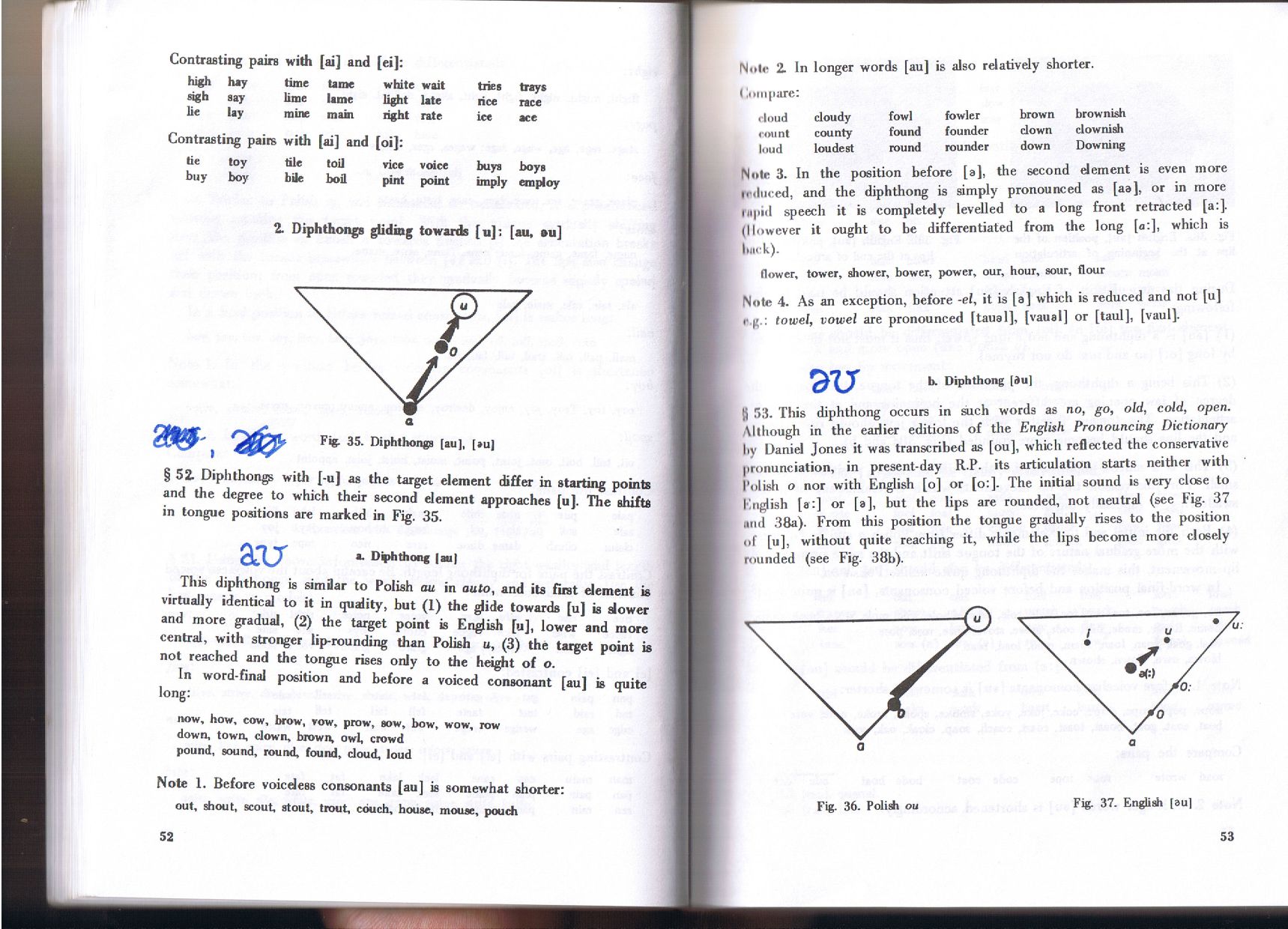CCF20100223�015

Contrasting pairs with [ai] and [ei]:
|
high |
hay |
limę |
tamę |
white |
wait |
tjjeg |
tray* |
|
s»gh |
say |
limę |
lamę |
light |
late |
lice |
race |
|
be |
Uy |
minę |
main |
right |
ratę |
ice |
ace |
|
Contrasting pairs with |
[ai] and |
łoi]: | |||||
|
tie |
toy |
tile |
toil |
rice |
voice |
buys |
boya |
|
buy |
boy |
bile |
bod |
pint |
point |
imply |
employ |
- Diphthongs gliding towards [n]; [au. au]

rm t Fig. 35. Diphthonp (au), [»u]
§ 52. Diphthongs with J-u] as the target element differ in starting pointa and the degree to which their second element approaches [u]. The shifts in tongue positions are marked in Fig. 35.
*• Diphthong |au|
This diphthong is similar to Polish au in auto, and its firat element is virtually identical to it in ąuality, but (1) the glide towards [u] is dower and morę gradual, (2) the target point is English [u], lower and morę central, with stronger lip-rounding than Polish u, (3) the target point is not reached and the tongue rises only to the height of o.
In word-final position and before a voiced consonant [au] is quite long:
now, how, cow, brow, row, praw, sow, bow, wow, row down, town, down, brown, owi, crowd pound, sound, round, found, doud, loud
Notę 1. Before voicdess consonants [au] is somewhat shortcr: out, shout, scout, atout, trout, couch, house, mouse, pouch
Nule Z In longer words [au] is also relatively shorter.
Umnpaie:
cloud doudy fowl fowler brown brownish
nnint county found founder down downish
loud loudest round rounder down Downing
Notę 3. In the poeition before [a), the second element is even morę reiliK-ed, and the diphthong is simply pronounced as [aa], or in morę rapid speech it is completely levelled to a long front retracted [a:] (II. >wever it ought to be differentiated from the long [«:], whicli is Itack).
Ilower, tower, shower, bower, power, our, hour, sour, flour Notę 4. As an exception, before -el, it is [a] which is reduced and not [u] fl.g.. towel, vowel are pronounced [taual], [vaual] or [taul], [vaul].
9U b. Diphthong |du|
ty 53. This diphthong occurs in such words as no, go, old, cold, open. Although in the eaHier editions of the English Pronouncing Dictionary by Daniel Jones it was transcribed as [ou], whicli reflected the conservativc pronunciation, in present-day R.P. its articulation starts neitlier with Polish o nor with English [o] or [o:]. The initial sound is very close to English [a:] or [a], hut the lips are rounded, not neutral (see Fig. 37 and 38a). From this position the tongue gradually rises to the position of [u], without quite reaching it, while tlie lips become morę closely rounded (see Fig. 38b).

Fig. 37. English [au|
Fig. 36. Polirfi ou
Wyszukiwarka
Podobne podstrony:
CCF20100223�015 Contrasting pairs with [ai]
CCF20100223�006 Worda with [ju:]: musc, musie, lunę, lunie, cube, cubic, due, duty, new, newest, Hun
CCF20101202�002 THE PRONUNCIATION OF THE SENTENCE, lb (from RK) WITH RHYTHM AND INTONATON ANALYSE AN
CCF20101027�001 generalisations without the The does nol inean ‘all’. We do nol usc the in generalis
fig20 Figurę 20 One possible Chain arrangement with shears and needle case
00069 }db5d1dc19534077081f7b2f44fe560 68 Hembree & Zimmer where wt ~ N(0, a2w ) with unknown an
Tests all recemng tubes (picture tubes with adapter), n-p-n and pn p transistors. Com-posite indicat
58 contrast to this androcratic and patriarchal order we find, in the oldest pre-Semitic and pre-Ind
str (133) CHAPTER II Yariarions of Viscosity with Pressure and Temperaturę. Yiscosity of Mixtures. V
kryzysy marokańskie (15) 396 □ The Franco-German Duel possiblc to cultivate our relations with Ameri
więcej podobnych podstron